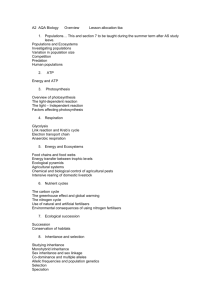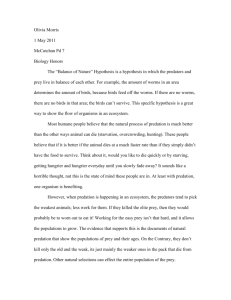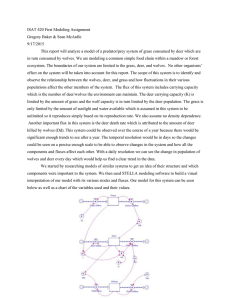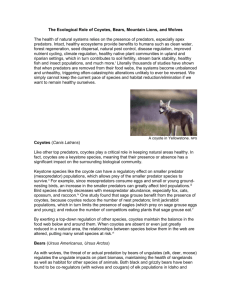mammal bond
advertisement
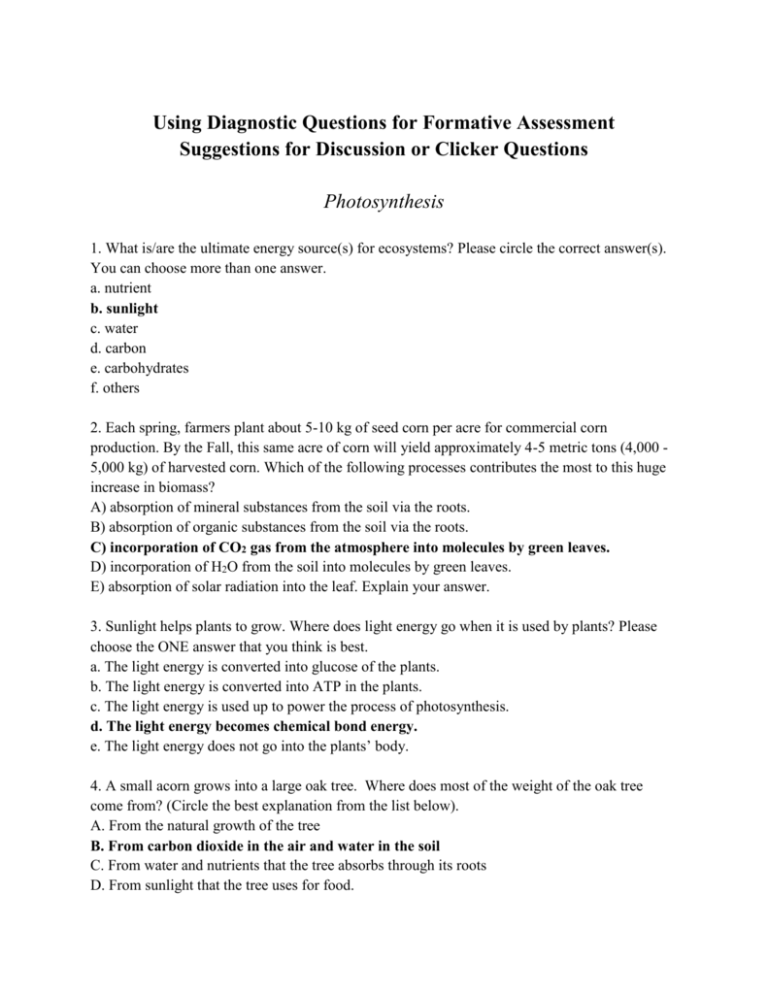
Using Diagnostic Questions for Formative Assessment Suggestions for Discussion or Clicker Questions Photosynthesis 1. What is/are the ultimate energy source(s) for ecosystems? Please circle the correct answer(s). You can choose more than one answer. a. nutrient b. sunlight c. water d. carbon e. carbohydrates f. others 2. Each spring, farmers plant about 5-10 kg of seed corn per acre for commercial corn production. By the Fall, this same acre of corn will yield approximately 4-5 metric tons (4,000 5,000 kg) of harvested corn. Which of the following processes contributes the most to this huge increase in biomass? A) absorption of mineral substances from the soil via the roots. B) absorption of organic substances from the soil via the roots. C) incorporation of CO2 gas from the atmosphere into molecules by green leaves. D) incorporation of H2O from the soil into molecules by green leaves. E) absorption of solar radiation into the leaf. Explain your answer. 3. Sunlight helps plants to grow. Where does light energy go when it is used by plants? Please choose the ONE answer that you think is best. a. The light energy is converted into glucose of the plants. b. The light energy is converted into ATP in the plants. c. The light energy is used up to power the process of photosynthesis. d. The light energy becomes chemical bond energy. e. The light energy does not go into the plants’ body. 4. A small acorn grows into a large oak tree. Where does most of the weight of the oak tree come from? (Circle the best explanation from the list below). A. From the natural growth of the tree B. From carbon dioxide in the air and water in the soil C. From water and nutrients that the tree absorbs through its roots D. From sunlight that the tree uses for food. Respiration 1. Your body produces heat to maintain its normal temperature. Where does the heat mainly come from? Please choose the ONE answer that you think is best. a. The heat mainly comes from sunlight. b. The heat mainly comes from the clothes you are wearing. c. The heat mainly comes from the foods you eat. d. The heat mainly comes from your body when you are exercising. 2. When an animal takes in O2 and releases CO2 during cellular respiration: A) The process increases the mass of the animal B) The process decreases the mass of the animal C) The process does not affect the mass of the animal. 3. When the leaves in a compost pile decay, what do you think happens to the mass of the leaves? Circle True (T) or False (F). T F The mass disappears when the leaves decompose. T F The mass is turned into heat energy. T F The mass is converted into soil minerals. T F The mass is converted into carbon dioxide and water. 4. Carbon exists in the atmosphere, where could it have come from? Circle all correct answers. A) Photosynthesis by plants B) Diffusion from the ocean C) Cellular respiration by plants D) Cellular respiration by animals E) Cellular respiration by bacteria F) Photosynthesis by fungi G) Burning of biofuels H) Burning of fossil fuels I) Depletion of the ozone layer Biosynthesis/Digestion/Matter and Energy Transfer and Food Webs 1. A remote island in Lake Superior is uninhabited by humans. The primary mammal populations are white-tailed deer and wolves. The island is left undisturbed for many years. Select the best answer(s) below for what will happen to the average populations of the animals over time. _____a. On average, there will be more deer than wolves. _____b. On average, there will more wolves than deer _____c. On average, the populations of each would be about equal. _____d. The populations will fluctuate, with sometimes more deer than wolves, sometimes more wolves than deer _____e. None of the above. Please explain your answer to what happens to the populations of deer and wolves. 2. Does a tree have carbon in its leaves? Yes No Does a tree have carbon in its wood? Yes No Does a tree have carbon in its roots? Yes No 3. Where does your body store energy for later use? Please choose the ONE answer that you think is best. a. Energy is stored in the form of matter. b. Energy is stored in the form of chemical energy. c. Energy is stored in the cell, but is separated from the matter of the cell. d. Energy is stored among the cells. e. The body does not store energy. Energy is produced when you need it. f. Other_______________________________________________ 4. Grandma Johnson had very sentimental feelings toward Johnson Canyon, Utah, where she and her late husband had honeymooned long ago. Because of these feelings, when she died she requested to be buried under a creosote bush in the canyon. Describe below the path of a carbon atom from Grandma Johnson’s remains, to inside the leg muscle of a coyote. NOTE: The coyote does not dig up and consume any part of Grandma Johnson’s remains.




